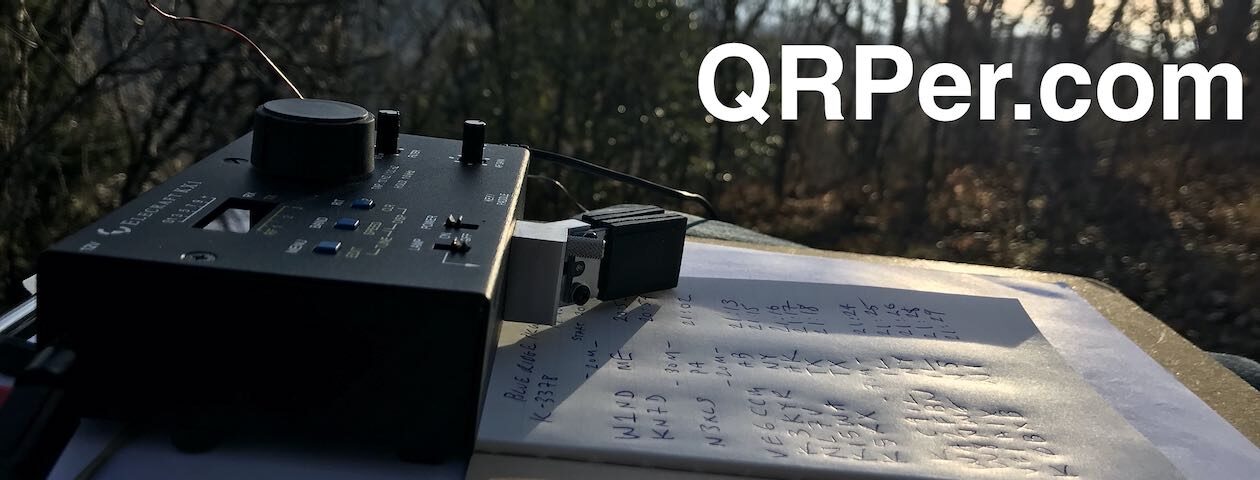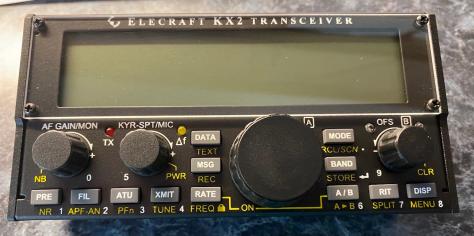Note that the following review first appeared in the May 2023 issue of TheSpectrum Monitor magazine.
Update: Also, please note that the G106 is on sale at Radioddity at time of posting. With our affiliate link pricing is only $264 US (see note at end of review). Please read this review prior to making a purchase decision!

An in-depth review of the Xiegu G106 QRP HF transceiver
by Thomas (K4SWL)
Last year––in May of 2022, that is––Xiegu announced a new compact field radio that would be added to their line of transceivers: the Xiegu G106.
Xiegu has really made a name for themselves over the past few years with several transceiver offerings, many of which have become very popular. Among these:
- The Xiegu G90 is a 20-watt transceiver with an excellent built-in ATU. The G90 has become a very popular field radio over the past few years.
- The Xiegu X5101 is a five-watt shack-in-a-box HF transceiver covering 160-6 meters. The X5105 has become a go-to QRP portable due to its fine built-in ATU and built-in rechargeable battery pack.
- The Xiegu X6100 is much like the X5105, in that it’s also a shack-in-a-box QRP transceiver, but it leverages SDR technology to provide a beautiful color spectrum display and a host of features not found on its predecessors. Many have adopted the X6100 because its operating system is Linux-based and many enthusiasts have created their own X6100 interface that promised direct digital mode operation.
Because we’re seeing more products like these from Xiegu, the up-and-coming Xiegu G106 stirred interest.
Moreover, Xiegu has become a low-cost leader among HF transceiver manufacturers. In each of the reviews I’ve published about Xiegu radios, my summary statement is that each unit offers a lot of performance for the price. Xiegu transceivers don’t have the most robust receiver front-ends, and the audio is unrefined, but their rigs get the job done and have some serious “fun factor.”
So when I first learned about the new Xiegu G106, I was curious where it would fit into their product line.
Introducing the Xiegu G106
 As I was capping off my summer in Canada back in August of 2022, Xiegu retailer Radioddity started shipping the G106. Radioddity had me on the list to send a loaner G106 for review, but upon my return I found myself so busy that I didn’t immediately request it.
As I was capping off my summer in Canada back in August of 2022, Xiegu retailer Radioddity started shipping the G106. Radioddity had me on the list to send a loaner G106 for review, but upon my return I found myself so busy that I didn’t immediately request it.
I did watch, however, K8MRD’s initial and updated review of the G106 on YouTube. While it was less than stellar––understatement alert––more relevant to me was that Mike shipped his second evaluation unit to me on behalf of Radioddity.
I connected that G106 to a dummy load, checked the transmitted signal on my SDRplay RSPdx spectrum display, and it simply didn’t look very clean. In fact, it looked worse than it did when Mike checked it only a couple of weeks prior.
I shared my results with Radioddity and told them I didn’t feel comfortable putting the G106 on the air; they asked that the unit be returned and checked out.
Fast-forward to January 2023, when I was once again contacted by Radioddity to see if I would like to field test an updated G106? I answered that I was happy to do so, because I was curious whether the G106 experience had improved.
In the spirit of full disclosure, keep in mind that Radioddity is a Xiegu retailer/distributor––the company is not the manufacturer, nor is it owned by Xiegu. They sent this G106 to me on an extended loan for an honest evaluation.

So where does the G106 fit into the Xiegu product line? It’s being marketed as a low-cost, entry level, multi-mode QRP HF transceiver that leverages 16-bit CODEC sampling to provide the user with a lot of radio for the price. It’s basic, and meant to be so, in that it’s only a transceiver; there is no built-in ATU or battery. The G106 is marketed as a bare-bones portable HF transceiver.
I feel like it hits this mark.
The G106 doesn’t have a lot of features or controls one might expect in other Xiegu radios, but it has more features than any other modern HF radio I know of in its price class (see features list below). Indeed, I can’t think of any other 80-10 meter general coverage QRP transceiver that retails for $320 or less. The G106 has this market niche to itself for the moment.
Overview
 When I first received the G106, I was a little surprised: it was even more compact than I had imagined.
When I first received the G106, I was a little surprised: it was even more compact than I had imagined.

The sides of the G106 are rounded and the chassis extends beyond the encoder and front controls of the radio, thus the interior is quite well protected in the event the radio is dropped. This is one of the few QRP field radios on the market that doesn’t need an aftermarket cage. I’ve been transporting the G106 in an old hard shell headphone case a friend gave me. The case isn’t large, but it easily holds the G106 and a power cord with a bit of room to spare.
The G106 sports a small monochrome backlit display that’s very easy to read in the shack or in the field with full sunlight.

Besides the weighted encoder (which has soft detents), the volume control, and microphone port, there are also four multi-function buttons located under the small display on the front panel. On top of the radio, there is a power/backlight button, mode/pre-amp button, and two band buttons that also can be pressed and held to change the frequency cursor position. The internal speaker is also mounted on the bottom of the top cover, just behind the top panel buttons.
 On the back of the G106, you’ll find a BNC antenna port, ground/earth lug, key port, COM port, 8 pin ACC port, and a DC input port.
On the back of the G106, you’ll find a BNC antenna port, ground/earth lug, key port, COM port, 8 pin ACC port, and a DC input port.
The most conspicuous omission is a headphone or external speaker port. I would have expected this in a QRP field radio because operators often prefer using headphones in the field rather than a speaker. I know that some G106 owners have built their own RJ9 audio plug to port out the audio to headphones. There is a headphone port on the supplied speaker mic, but CW-only operators might prefer a more direct way to connect earphones in order to keep the bulk of their field kit to a minimum.
What is surprising is that the G106 has a very basic spectrum display that is actually quite useful!
Ergonomics
 The ergonomics of the G106 are overall pretty good…but a bit quirky. To be honest, giving the user access to numerous functions and features on a radio this small is always going to affect ergonomics; there’s only so much control-surface real estate. Continue reading An in-depth review of the Xiegu G106 QRP HF transceiver →
The ergonomics of the G106 are overall pretty good…but a bit quirky. To be honest, giving the user access to numerous functions and features on a radio this small is always going to affect ergonomics; there’s only so much control-surface real estate. Continue reading An in-depth review of the Xiegu G106 QRP HF transceiver →
 As mentioned in my previous POTA field report, I had the great pleasure of playing POTA on May 21, 2023 with a number of friends. We all played hooky on the final day of Hamvention. The first two activations of the day were with Vince (VE6LK/AI7LK), Charlie (NJ7V), Eric (WD8RIF), and Miles (KD8KNC).
As mentioned in my previous POTA field report, I had the great pleasure of playing POTA on May 21, 2023 with a number of friends. We all played hooky on the final day of Hamvention. The first two activations of the day were with Vince (VE6LK/AI7LK), Charlie (NJ7V), Eric (WD8RIF), and Miles (KD8KNC). For more details on this activation from Eric’s perspective, click here!
For more details on this activation from Eric’s perspective, click here!
















































